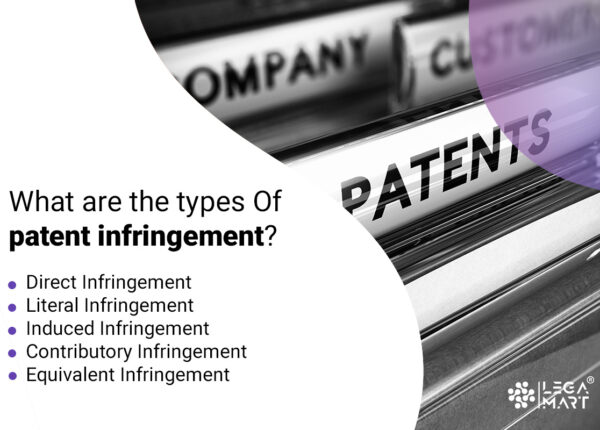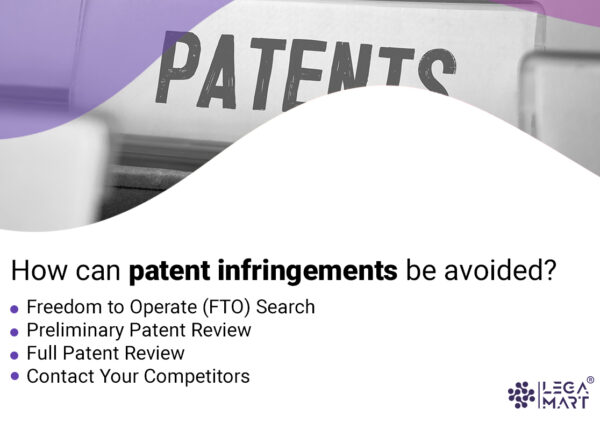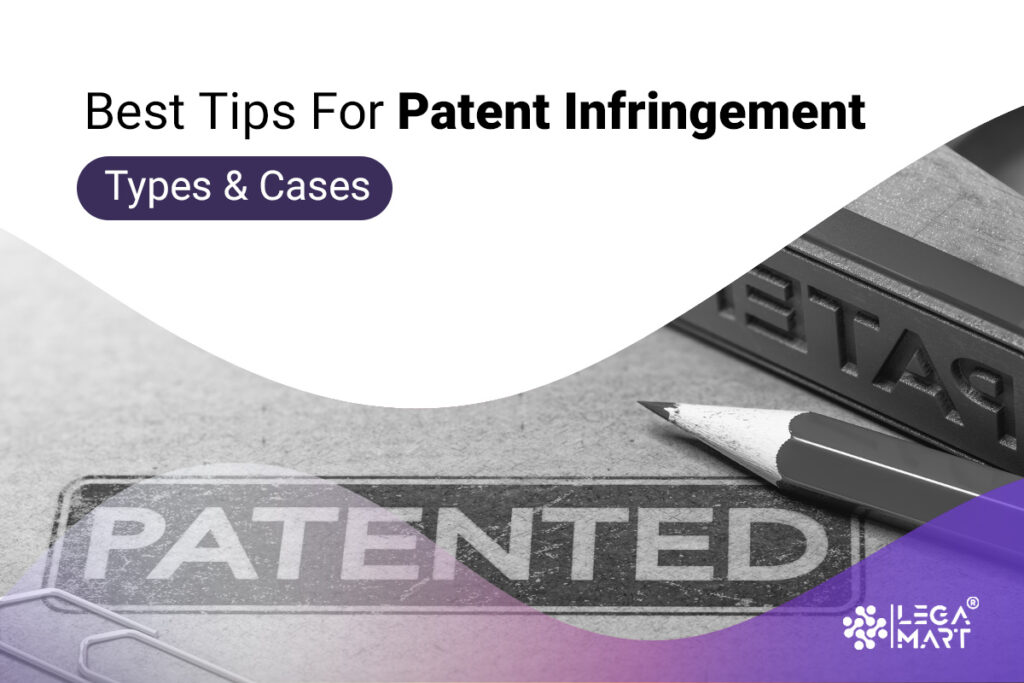- Introduction
- What Is a patent?
- What Is patent infringement?
- What are the types Of patent infringement?
- What are the elements of a patent infringement claim?
- The ‘doctrine of equivalents’ under patent infringements
- Relevant case law on the ‘doctrine of equivalent.’
- How can patent infringements be avoided?
- Patent infringement lawsuits
- Interesting Cases Of Patent Infringement
- Damages For Patent Infringement
- Patent Infringement FAQ
- Conclusion
Introduction
I gathered a couple of disused iPhones from my friends, dismantled them, and sold the iPhone chips to a professor in the engineering department. A month later, the rumour spread around campus that the professor had assembled an iNotebook, which was good. Until two gentlemen showed up at my doorstep on my eighteenth birthday, flashing their Apple IDs. A few hours ago, I was a child, but now that I was an adult, I was doomed to bear the brunt of the law. In what turned out to be a Cross-Border & International Law issue, I had infringed on a patent.
What Is a patent?
A patent is a legal right granted to an inventor of a new product, idea, or process by an authorised government agency. This right lasts fourteen to twenty years from the date of a patent application, depending on the type of patent, and prevents anyone else from carrying out any of the activities specified in the patent claim, allowing the patent owner to exploit his invention without competition commercially.
What Is patent infringement?
Patent infringement is a situation whereby a person, known as the infringer, carries out any activity that is prohibited with respect to a patent claim without the permission of the patentee. Such activities could be making, selling, using, or importing the patented product within the region to which the patent applies. For example, if a patent was issued in the US, a competitor in Germany can freely exploit the invention without any legal consequences, as he won’t be guilty of patent infringement. Both Copyright and Patent infringement demand attention and legal protection in this era of social media where information and innovation travel fast.
What are the types of patent infringement?

Direct Infringement
When the infringer duplicates, sells, uses, and imports the patented product without the permission of the patent owner, he’s liable for direct infringement.
Literal Infringement
Usually, this is the most painful and annoying type of patent infringement. Imagine duplicating a patented invention feature for feature. It is similar to plagiarism in literature.
Induced Infringement
This revolves around persuading or encouraging another person to violate a patent. The infringer will be roped into infringement lawsuits and penalised with a sufficient percentage of overall damages determined by law.
Contributory Infringement
When an entity makes, sells, or imports a unique item specified in the patent claim, and the only obvious use of that item is the production of the patented invention, they have committed contributory infringement.
Equivalent Infringement
This occurs when a competitor manufactures a good that is assembled using components that are significantly similar to the elements of the patent claim. It can also be viewed from the angle of the competitor’s product performing the same function or achieving the same result as the patented item. Then, relying on the case law known as the Doctrine of Equivalence (DOE), the aggrieved patentee can sue the suspect.
However, if the patent owner narrows the coverage of his patent claim at the stage of patent application but proceeds to broaden it later to have enough grounds to sue the accused, his lawsuit will be dismissed.
What are the elements of a patent infringement claim?
If someone is accused of using or making an invention without the patent holder’s permission, a legal action, known as a patent infringement claim, can be taken against such a person. For a patent holder to make a patent infringement claim, they must establish the following elements:
- Ownership and validity of a Patent: The patent holder must show that they own the patent for the invention.
- Most patent ownership can be proved through patent registration documents. However, where transfer and assignment have been done, proving ownership can require several documents.
- On the other hand, the validity of a patent involves whether the patent in question meets the legal requirements for patentability and is enforceable, such as novelty, non-obviousness and usefulness.
2. Infringement: The patent holder must be able to identify the infringer (the defendant) and the infringement, i.e. by demonstrating that the defendant is using, making, selling, or importing a product or process that falls within the scope of the claims of the plaintiff’s patent.
3. Direct or Indirect Infringement: The plaintiff must show that the defendant has directly infringed on the patent, which means that they have used or made the patented invention themselves, or indirectly infringed, which means that they have contributed to or induced another person or entity to infringe on the patent. The patent holder must demonstrate how the defendant’s invention or product infringes each allegedly infringed claim.
4. Damages: The patent holder must demonstrate that they have suffered damages as a result of the infringement, such as lost profits or reasonable royalties, e.t.c
The ‘doctrine of equivalents’ under patent infringements
The doctrine of equivalents is founded on the idea that a patent holder should be protected from products or processes that are substantially the same as their invention, even if they use slightly different technologies or methods.
It is commonly used where the patent holder’s product or process has been modified to avoid literal infringement of the patent in question. Thus, the doctrine can be applied to determine if the modified product or process infringes the patent under an equivalent theory.
The role of this doctrine in patent infringement is to prevent potential infringers from stealing the profit of a patented invention by modifying only insignificant details of the claim while retaining a substantial part of its functionality.
Relevant case law on the ‘doctrine of equivalent.’
This doctrine was applied in a recently decided case of Sotefin SA v. Indraprastha Cancer Society and Research Centre & Ors., CS(COMM) 327/2021 in India.
In this case, Sotefin SA (the plaintiff) filed a patent infringement suit against Indraprastha Cancer Society and Research Centre and others (the defendants) for infringing on their patent related to a robotic system for handling containers.
The plaintiff’s product, commonly known as a dolly, was patented and registered in March 2002, which was to expire in March 2022. The plaintiff filed a suit against the defendants for infringement of the said registered patent being “carriage for the horizontal transfer of motor vehicles in automatic mechanical car parks”, a robotic system for handling containers.
The plaintiff argued that the pictures of the defendants’ smart dollies resembled its silomat dollies. Therefore, the court appointed a team of scientific experts to compare some features of both parties’ respective dollies to establish infringement on the plaintiff’s patent. Based on the scientific report, the findings were that seventeen (17) of the nineteen (19) sub-elements between the respective dollies were found to share common features.
Further, the plaintiff claimed that the claims in the registered patent had similar input-output functions to the smart dollies as both had the same functionality. The defendants, on the other hand, argued that their product did not infringe on the patent as it did not meet all the elements of the patented invention, as the two (2) essential elements were absent in their smart dollies. However, the court found that the absence of the said two (2) essential elements could not be interpreted as vital to the extent of rendering the dollies significantly dissimilar.
The court considered the doctrine of equivalents and noted that it applies when the accused product or process performs substantially the same function, in the same way to achieve the same result as the patented invention.
After analysing the claims of the patent and the defendant’s product, the court held that the defendant’s product did not infringe on the plaintiff’s patent. The court noted that the plaintiff failed to establish that the defendant’s product was an equivalent of their patented invention.
This case highlights the importance of carefully analysing the claims of a patent and the accused product or process when applying the doctrine of equivalents as well as how the doctrine should be applied with caution, particularly when it is clear that the accused product or process is an equivalent of the patented invention.
How can patent infringements be avoided?

Freedom to Operate (FTO) Search
Typically, the FTO is the liberty to implement your technology, market your product or commercialise your new invention. Undertaking an FTO search while your product is still conceptualising is risk-efficient and safer for your business. Typically, you can look up patent search keywords related to your patent claims to find out if there are similar patents already in place. Although the freedom to operate is generally greater in less competitive industries such as interior decoration, you can always identify and omit patented features from your product and reduce the risk of patent infringement.
Preliminary Patent Review
Although it is not as thorough as a full review, it can help determine the likelihood of your product infringing on a patent upfront. If the similarities discovered by your attorney are minor and easily amenable, you may choose to make the changes they suggest and end your review at this point.
Full Patent Review
When a preliminary patent review indicates a higher risk of patent infringement, it’s a good idea to ask your attorney for a full review. In addition, if your company operates in a field where patent litigation is common, and your business risks are millions of dollars, you should thoroughly examine multiple patent claims.
Contact Your Competitors
For some reason, you may not find information regarding your competitors’ patent claims online. Or, you might have all the information you need but want extra assurance that you won’t infringe on their patents. By reaching out to your competitors, you demonstrate due diligence, which the court will consider should any charges be brought against you later. If your competitors agree that your product does not infringe on their patent now but go ahead to file infringement claims afterwards, they will be stopped (prevented from doing so by law).
Sometimes when the universe turns against you, you could implement these methods but land in a patent infringement lawsuit. That’s why you need a defensive patent insurance policy to protect you against financial risks that arise from patent infringement. Most defensive insurance policies are comprehensive, covering litigation fees, settlement fees, and damages (if you lose the case), so as long as you pay the premium regularly, you have nothing to worry about.
Patent infringement lawsuits
They are the easiest way to make or lose millions of dollars in the legal arena, from the costs of hiring a lawyer to the outrageous damages the court imposes on the loser. Most competent attorneys charge between $5000 to $15000 for a single patent infringement lawsuit.
Before you file patent violation charges against a business, ensure that your claims are valid and win-worthy; otherwise, you’ll lose money and suffer a dent in your company’s reputation. The most popular defences against a patent infringement claim are proving the invalidity of the patent or proving that the accused product did not infringe on the accuser’s patent. Also, remember that patent infringement is time-barred, meaning any lawsuit regarding this civil wrong must be set in motion within six years from the infringement date.
Interesting Cases Of Patent Infringement
Samsung v. Apple
The two smartphone giants have been taking turns slapping each other with patent lawsuits since April 2011, seeking and gaining damages of over $700 million in total across the Federal Circuit and the Supreme Court.
Microsoft v. i4i
In 2007, i4i sued the giant tech company for incorporating the XML editing and processing feature into Ms. Word 2007, infringing on i4i’s ‘449 patent. Surprisingly, the jury rejected Microsoft’s defence that the ‘449 patent was invalid and awarded i4i $200 million in damages.
Kraft Food v. TC Heartland
TC Heartland, a food product company incorporated in Indiana, allegedly imported infringing beverage sweeteners into Delaware. When Kraft Food sued TC Heartland, they contended that the case should be tried in Delaware because that was where the act of infringement was committed. At first, the Federal Circuit ruled in Kraft Food’s favour, but the Supreme Court reversed the judgment.
Intel v. VLSI
The jury ordered the world’s biggest chipmaker to pay VLSI $2.8 billion in 2021 for infringing on the latter’s patents. However, Intel rejected the verdict, claiming the charges were too exorbitant and sought a retrial.
Kellogg Co. National Biscuit Co.
Kellogg waited until Henry Perky died in 1908 __ and his two patents on his new cereal, plus the machines used to produce them, expired three years later__ before introducing Kellogg’s cereal. National Biscuit, the successor of Perky’s company, sued Kellogg for copying the shape and size of Perky’s cereal. Unfortunately, they lost the suit because the patents had expired. Therefore Kellogg was not guilty of infringement.
Damages For Patent Infringement
Lost Profits
The court awards lost profits when the plaintiff has been able to prove that the infringer’s actions negatively affected his business, lured his customers away, and significantly reduced the profits he should have made.
Reasonable Royalties
When the lost profits cannot be proven, the court estimates the royalties that should be paid to the plaintiff for making, selling, or using his patented invention.
Injunctive Relief
An injunction is a court order to do or stop doing something. In this case, injunctive relief is a temporary court order to stop infringing on the patent claim. It is usually issued in the early stages of a trial when it’s clear the plaintiff will most likely win anyway.
Patent Infringement FAQ
What is patent infringement?
Patent infringement is the unauthorised use, manufacture or sale of a patented invention by someone other than the patent holder. It occurs when someone makes, uses, or sells a product or process that is covered by the claim of an existing patent without the permission of the patent holder.
What should be done if your patent is infringed?
As a patent holder, you can file a lawsuit against the alleged infringer to stop them from using or selling your patented invention and to seek damages for any losses incurred due to the infringement. You can also seek orders for an injunction to prevent the infringer from further infringement.
What are the requirements for patent infringement?
In order to prove infringement, a patent holder must show that the alleged accused’s product or process meets all the elements of their patent claims. Therefore, a successful infringement claim must show that the accused product or process is identical or substantially similar to the patented invention.
Do you seek a patent infringement lawyer?
At Legamart, we have gathered the best intellectual property attorneys dedicated to offering helpful legal advice and winning your case. Create a free account, post your job, choose your favourite competitive bid and start working with your lawyer immediately!
Conclusion
Patent infringement is the unauthorised use of a patented invention, process, or product without the permission of the patent holder. Patent law, on the other hand, safeguards the patent holder’s exclusive rights to the use or sale of their inventions. In case of patent infringement or violation of such exclusive rights, a patent holder can institute a lawsuit to recover damages for infringement and obtain injunctions against further infringing activities.
Therefore, determining patent infringement requires a critical analysis of the scope of the registered patent claims and the accused’s product or process. The doctrine of equivalents is a legal principle used to determine whether an accused product or process is equivalent to the patented invention, even if it does not meet all the elements of the patent claims. However, the doctrine should only be applicable when it is clear that the accused product or process is equivalent to the patented invention.




